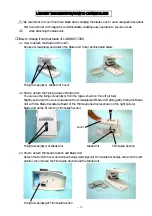
IKA
-WERKE C 2000 basic / control
Ver. 04 08.07
3DJH
&DORULPHWULFPHDVXUHPHQWV
'HWHUPLQDWLRQRIJURVVFDORULILFYDOXH
Combustion processes take place in a calorimeter under defined conditions. For this
purpose, the decomposition vessel is coated with a weighed out quantity of fuel
sample, the fuel sample is ignited, and the increase in temperature of the calorime-
ter system is measured. The specific gross calorific value of the sample is calculated
from:
•
the weight of the fuel sample
•
the heat capacity (C value) of the calorimeter system
•
the increase in temperature of the water within the inner vessel of the measuring
cell
To optimize the combustion process, the decomposition vessel is filled with pure
oxygen (99.95%). The maximum level of pressure of the oxygen atmosphere in the
decomposition vessel is 30 bar.
The exact determination of the gross calorific value of a substance requires that the
combustion proceed under precisely defined conditions. The applicable standards
are based on the following assumptions:
•
Depending on the mode that is set, the temperature of the fuel before the com-
bustion is 25 °C or 30 °C.
•
The water contained in the fuel before the combustion and the water that is
formed when compounds comprising the fuel containing hydrogen undergo
combustion is present in a liquid state.
•
No oxidation of the atmospheric nitrogen has taken place.
•
The gaseous products after combustion consist of oxygen, nitrogen, carbon
dioxide and sulfur dioxide.
•
Solid substances may be formed (for example ash).
Often, however, the combustion products that form the basis of the standards are
not the only products that are formed. In such cases, an analysis of the fuel sample
and the products of combustion are necessary to provide data for a correction cal-
culation. The standard gross calorific value is then determined from the measured
gross calorific value and the analysis data.
The gross calorific value Ho is formed as the quotient of the amount of heat liber-
ated upon total combustion of a solid or liquid fuel and the weight of the fuel sample.
The compounds comprising the fuel that contain water must be present in liquid
state after the combustion.
The heat value Hu is equal to the gross calorific value less the energy of condensa-
tion of the water that was contained in the fuel and was formed by the combustion.
The heat value is the more important quantity for technical purposes, since in all
important technical applications, the heat value is the only quantity that can be
evaluated in terms of energy.
H[SHULPHQW
FRQGLWLRQV
KHX
JURVVFDORULILF
YDOXH+R
Artisan Technology Group - Quality Instrumentation ... Guaranteed | (888) 88-SOURCE | www.artisantg.com
















































